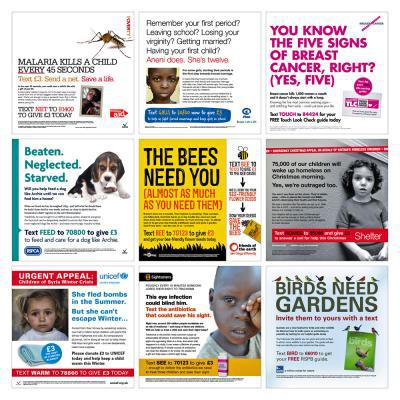Why the dumbest things your smartphone does are the smart things to do
Unless you’re a hermit or a latter-day Luddite, you have a mobile phone. And given SOFII’s readership demographic, it’s probably a smartphone that’s starting to act as a kind of seventh sense for staying in touch with the world.
- Written by
- Fiona Pattison
- Added
- April 22, 2012
In short, your mobile isn’t just another gadget. It’s part of you and it’s changing the way you act and the way you interact. So it’s very important that you find a way into your supporters’ phones.
But instead of rushing headlong over the bleeding edge of technology, the best place to start is with the most simple, mundane things your mobile does – which means sending texts and, yes, enabling telephone conversations!
Supporters will respond by text
Smartphone penetration in the UK just went past 50 per cent. But texting shows no signs of going out of fashion. On average, we send 50 texts a week, so one (or two) more to a charity is no hassle.
In short, text is our favourite, frictionless communication method – which is why it works so well for advertising.
The first campaign to spark interest in the potential of fundraising through mobile phones was Save the Children’s 2009 press ad for Gaza. The call to action was a hand-raiser – asking people to sign a petition calling on the UK government to lobby for a ceasefire: 180,000 people sent a SMS to mark their support. That’s 180,000 direct responses from three days of advertising in the broadsheet press. Nothing in recent memory compared. There hadn’t even been time to set up an URL or in-bound phone line.

We’ll never know how many of those 180,000 people would have given a micro-donation of £3 or even £1 because, sadly, cost-effective SMS donations didn’t exist back in the dark days of the noughties.
The following year, however, dedicated charity short codes were created (exempt from VAT) and the networks dramatically increased the percentage of each mobile donation that would be paid out.
Comic Relief saw this and ran with it. And in 2011, 81 per cent of the 5.3 million donations they received came via text.
These two staggering examples proved that, with a strong proposition, mobile phones could generate response – at volume. As a result, charities and agencies began to consider the opportunities of bringing mobiles to the front and centre of their fundraising campaigns.
Text reinvigorates channels
Four years later, we’re seeing that text messaging is changing and redefining the way that people interact with fundraising channels. A few years ago, ‘out-of home’ (OOH) channels weren’t working for fundraisers; the media cost could not be justified because of the relatively low direct response.
Text has changed this and we’ve seen it work particularly well in channels with high levels of ‘dwell time’.
Dwell time refers to those moments in which a captive audience has little else to do but read your ad. We’ve seen that packed commuter trains going in and out of major cities offer the perfect opportunity to make the most of dwell time. Text calls to action work on train ads because a text can be sent quickly and discreetly. And whether we’re asking for a micro-donation, putting out a campaigning ask, or offering something in return, every response delivers us a phone number.
We can’t forget the basic principles – a bold proposition, a strong ‘itch’ and ‘scratch’ and a clear (and legible – designers please note!) call to action. Three years ago, we worked with Christian Aid to create this nets campaign – truly putting mobile at the centre of the proposition.

The combination of dwell time and a strong proposition regularly recruits cost-effective prospects. When paired with strong telemarketing campaigns, we’re seeing large volumes of donors being recruited at a favourable cost.
And it’s not just train panels. Tubes, toilets and TV are all reliably delivering mobile prospects and regular givers at scale. And this summer we’ll all be watching closely as mobile takes centre stage in a number of high-profile street campaigns.

Text fundraising supports traditional fundraising models
Mobile fundraising is not a venture into the unknown. We’re not looking to overthrow the core principles of tried and tested models. The campaigns outlined above work on a traditional two- or three-stage conversion model, with mobile ‘micro-donors’ or hand-raisers being moved to regular giving.
And for the first time there is a genuine alternative to direct debit.
In 2010 Phonepay Plus, the UK mobile payment regulator, granted the charity sector exemption from regulation requiring charities to offer mobile phone donors the option to stop their regular donation at the point of every payment.
Donors are now given the option to skip a payment instead. This is a major innovation and has led to the evolution of mobile regular-giving platforms such as Mobilise. Now, donors have real control over their monthly gifts to charity – and can give anonymously if they wish. We work with donors, our clients and our partners to understand which offering is strongest for different audiences.
Text can spread a charity’s message
Many charities exist not only to raise funds but also to spread a message – whether that be raising awareness, providing information, or education. When the objective is to reach as many people as possible it makes sense to involve the mobile phone.
St John Ambulance was one of the first charities to test the theory that the frictionless nature of a text could generate high volumes of requests for information – in this case, pocket first-aid guides. It generated hundreds of thousands of responses – in fact, ads had to be scheduled to allow fulfilment houses to keep up with demand.
Last October, Breakthrough Breast Cancer tried something similar with great success. Their ‘TLC’ guide – which educates women about the signs of breast cancer – was promoted in dwell-time channels. Everyone who sent a free text requesting the guide was called so that they could give their address details – and female responders were also offered a monthly text reminder to check themselves.
On the same call, people were asked for a regular gift and enough said yes to make the campaign a highly cost-effective fundraising channel as well as a brilliant information distribution system.
People read texts
As fundraisers, we have a responsibility to our beneficiaries to foster new donors, keep them up to date with how their support is helping and driving them to take further action. And we’re seeing an increasing number of retention teams delivering welcome and stewardship programmes via text.
This is something other sectors do very well: schools text parents about snow days; supermarkets remind customers when their delivery is due; pizza shops offer discounts. And there are numerous opportunities for charities, too: a text with a sneak preview of a new DRTV ad; an ask to take part in an event; an emergency update or just an extra thank you once in a while.
But if you think this all sounds like your ‘e-newsletter’ programme, think again. You see, for the moment at least, people actually read texts – 90 per cent of them within three minutes.
So while mobile stewardship is starting small, it’s going to get big fast. Because if charities can ‘own’ just a little space on their donors’ mobiles, they can place themselves in a strong position to retain support and ask donors to give again, or give more.

Amnesty’s SMS network, Pocket Protest, was designed to recruit ‘mobile activists’ – supporters who will escalate messages defending human rights.
This feels like an authentic way to spread a message and ask for micro-actions to be taken. Sending a text to everyone on the network asking them to sign a petition by replying with their name combines urgency, a sense of personalisation and an active commitment from the responder, to hugely powerful effect.
Running to stand still
SMS is almost an antique in technological terms – but its combination of payment and communication has driven fundraising and driven innovation. But the mobile, as a tool for fundraisers, is only taking its first baby steps.
We’ll be writing again soon about the more esoteric aspects of what smartphones are doing to the fundraising world. Until then, SMS offers plenty of potential to keep us busy.





















